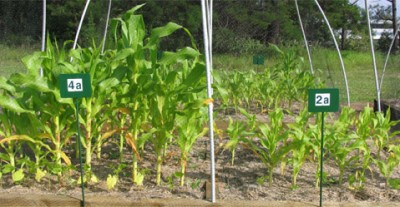Life-giving carbon can be our salvation in the climate crisis, if only we can shake off old mindsets. [5 February 2008 | Peter Boyer]
Carbon is the essence of life. Large amounts of it are in our bodies and in every living thing on the planet. Animals breathe it out as carbon dioxide, and plants grow by taking it in – part of the carbon cycle, the cycle of life.

Both plots of corn were planted at the same time in identical soil, except that the corn at left grew from soil fed with extra carbon as biochar.
Except that our own species has found many new ways of putting extra carbon into the atmosphere, throwing the cycle of life out of kilter and endangering all the life forms that it has sustained down the millennia.
We’ve left nothing alone. While burning Earth’s fossil deposits, polluting its atmosphere and pushing our soils to produce more food, we’ve also degraded their capacity to do so. We’re a demanding species.
We’re also clever. What we’ve done, we ought to be able to undo. If only we can get our act together, we ought to be able to put our minds to how we might stop so much carbon entering our atmosphere.
Most talk about carbon storage (sequestration) has focused on the technology of “clean coal”, whereby carbon emitted from coal-fired power stations would be captured and put into underground vaults.
The technology demanded by the “clean coal” idea is complex, expensive and unproven, and it requires large-scale centralised systems. But the climate crisis demands decentralised solutions, with shared responsibility for action and distributed power generation.
Here’s an idea that, unlike “clean coal”, is within reach of local authorities and serves multiple purposes. While keeping carbon out of the atmosphere and generating electricity, it can also make our soils more productive.
Tasmania has no shortage of plant waste, rich in carbon. Much of it disappears into the atmosphere by burning, or is left to rot and relinquish its carbon over time. We can put it to better use.
Biochar (“bio” as in plant matter, and “char” as in charcoal) is a product that its advocates believe can replicate the ways in which the world’s most fertile soils – “terra preta” or “dark earth” – cycle their nutrients, hold their water, and grow plants better than anywhere else.
Biochar is basically small granules of charcoal obtained through heating plant waste in an age-old process called pyrolysis, by which we once produced charcoal for fuel. Modern pyrolysis technology reduces carbon emissions to practically zero while producing heat that can generate sufficient electricity to power some small industrial plants.
The residue from the process is carbon in the form of biochar, and this has the capacity to revitalise our soils, giving long-lasting fertility while also improving moisture-carrying capacity.
That’s making carbon work for us, not against us. Which is the way nature always intended.
How pyrolysis might help Tasmania
Slow-pyrolysis technology can use any organic waste, including roadside grasses, woody weeds, waste wood from tree and forest management, and even dried manure and sludge from settling ponds.
The combustion process produces electricity and granular char – a highly-effective, easily-transported fertiliser. The char can also be used in water filtration, and may be pelletised for ultra-clean fuel in fire heaters – especially useful in places with an air inversion problem.
The best near-term application of the technology in Tasmania is in the two major Bass Strait communities on King and Flinders Islands.
These communities are not connected to the national electricity grid. Wind and diesel generators provide power to the islands, maintained by Hydro Tasmania – at a significant cost. The price of diesel will rise significantly with the introduction of a national emissions trading scheme in two years’ time.
A further incentive for King Island to look for alternative power sources is the impending reopening of the island’s scheelite mine at Grassy.
The monetary value of biochar will become clearer with introduction of the Federal Government’s 2010 emissions trading scheme, but its value to our tired, old soils is abundantly clear.
